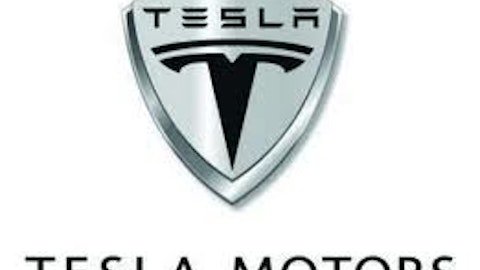It’s tempting to think car companies such as Tesla Motors Inc (NASDAQ:TSLA) and Nissan Motor Co., Ltd. (ADR) (OTCMKTS:NSANY) were the first to introduce electric vehicles to world. Of course no car company before them has been able to bring such technologically advanced electric cars to the mass market — or sell as many as they have — but the electric car has had a long history before these two companies came into existence.To fully understand today’s electric automotive market, let’s look at how electric vehicles got their start.
In the beginning
According to PBS, Scottish inventor Robert Anderson built the first electric car somewhere between 1832 and 1839. Unfortunately for Anderson — and the budding horseless-carriage industry — rechargeable batteries weren’t invented until 1859, posing some serious hurdles for the electric car.
In the United States, electric cars, or EVs, burst onto the scene in 1891, when William Morrison built the first electric automobile in the country. Six years later, New York City introduced the first electric taxis built by the Electric Carriage and Wagon Company — later called the Electric Vehicle Company. The taxis were able to run all day by swapping out batteries (sound familiar?) and charging up every few hours. In its prime, the Electric Vehicle Company operated the largest electric-vehicle assembly plant in the world and had more than 2,000 electric vehicles in its fleet — but an undersupply of batteries and problems updating the electric technology caused the company go out of business in 1907.

The Electrobat car was the basis for the Electric Vehicle Company’s taxicabs. Photo: public domain.
In 1900, about 28% of the more than 4,000 vehicles produced in the U.S. were powered by electricity. But a combination of mass-produced Model Ts, the invention of the automotive electric-start, the lack of electric range and horsepower, and the gasoline engine’s prevalence virtually killed the idea of the electric car.
The resurgence, and death, of the electric car
In the 1970s, several government agencies became interested in the environmental and political benefits of electric vehicles, with the idea that EVs could reduce emissions and wean us off foreign oil at the same time. Around that time, the U.S. Postal service bought hundreds of electric vehicles from AMC, and Congress passed the Electric and Hybrid Vehicle Research Development and Demonstration Act in pursuit of better batteries and electric motors.
But years before the Arab Oil Embargo, General Motors Company (NYSE:GM) was experimenting with the battery-powered Chevrolet Electrovair. The company made two versions of the vehicle, with an electric range of up to 80 miles, but never brought the vehicles to market. Over the next 30 years, General Motors Company (NYSE:GM) experimented with the 512 Series, the Electrovette, and other prototypes — but it wasn’t until 1996 that it introduced the infamous EV1.

EV1 cars. Source: Plug in America (Creative Commons license).
The car was leased to customers on a three-year term, and the second-generation vehicles had a 125-mile range. It was built primarily to meet a California zero-emissions mandate, but when state regulations were changed, General Motors Company (NYSE:GM) let customer leases expire and killed off the vehicle in 2003. The EV1 cost GM a total of $1 billion in the end.
A hopeful return
Even with the electric vehicle’s difficult past, it’s not hard to imagine its future is on the mend. This year Tesla Motors Inc (NASDAQ:TSLA)’s all-electric Model S received a score of 99 out of 100 from Consumer Reports, was named Automobile Magazine‘s 2013 Automobile of the Year, and is the 2013 Motor Trend Car of the Year. The company just made it through its second profitable quarter — a major feat for a young electric-car company — and its stock has surged 370% since the beginning of the year.
Tesla Motors Inc (NASDAQ:TSLA) now has a valuation of $20 billion — almost half of General Motors’ market cap.

Tesla Model S. Source: Tesla.
Though Tesla Motors Inc (NASDAQ:TSLA) is projected to sell 21,000 Model S vehicles this year, it’s just a fraction compared with Ford Motor Company (NYSE:F)‘s sales of 1.5 million in the U.S. already this year. But the vehicle sales comparisons aren’t completely fair — with Tesla Motors Inc (NASDAQ:TSLA) being a much smaller and newer company — as well as selling just one vehicle in its lineup right now.
But Tesla Motors Inc (NASDAQ:TSLA)’s not the only company pushing the electric car back into relevance. Last month Nissan Motor Co., Ltd. (ADR) (OTCMKTS:NSANY) sold nearly 1,900 of its electric Leafs — 372% more than it did in July of last year — which brings the total to 11,703 Leafs sold so far this year. Nissan Motor Co., Ltd. (ADR) (OTCMKTS:NSANY) says the car is the best selling EV in history.

Nissan Lead NYC Taxi. Source: NYC Taxi and Limousine Commission .
Just as with the beginning of the electric vehicle back in the early 1900s, the Leaf is currently being used as a taxicab in New York City as part of a one-year pilot program. The Leaf taxicabs have have the same shifts as gasoline-powered cabs and take advantage of quick charging stations in the city to replenish batteries to 80% in just 30 minutes. Hopefully these electric-powered taxicabs will have a longer history than earlier EV cabs.
It’s important to point out that in addition to the companies we’ve mentioned, automotive manufacturers such as Honda, SMART, BMW, Ford Motor Company (NYSE:F), Toyota, Mitsubishi, Fiat, and others either have EVs on the road now, or have them in the works. While the automotive industry has taken a while to turn the tide — at lease partly — back to electric vehicles, it still has a long way to go. As the EV industry grows, consumers — and investors — will need to see battery costs decline and consumer demand increase. Both of these factors are paramount in keeping electric vehicles on the road and avoiding EVs’ troubled past — but for now it seems things are moving in the right direction.
The article Tesla Motors Is Trying to Prove History Doesn’t Repeat originally appeared on Fool.com is written by Chris Neiger.
Chris Neiger has no position in any stocks mentioned. The Motley Fool recommends Amazon.com, Apple, Facebook, Ford, General Motors, Google, and Tesla Motors and owns shares of Amazon.com, Apple, Facebook, Ford, Google, and Tesla Motors.
Copyright © 1995 – 2013 The Motley Fool, LLC. All rights reserved. The Motley Fool has a disclosure policy.




